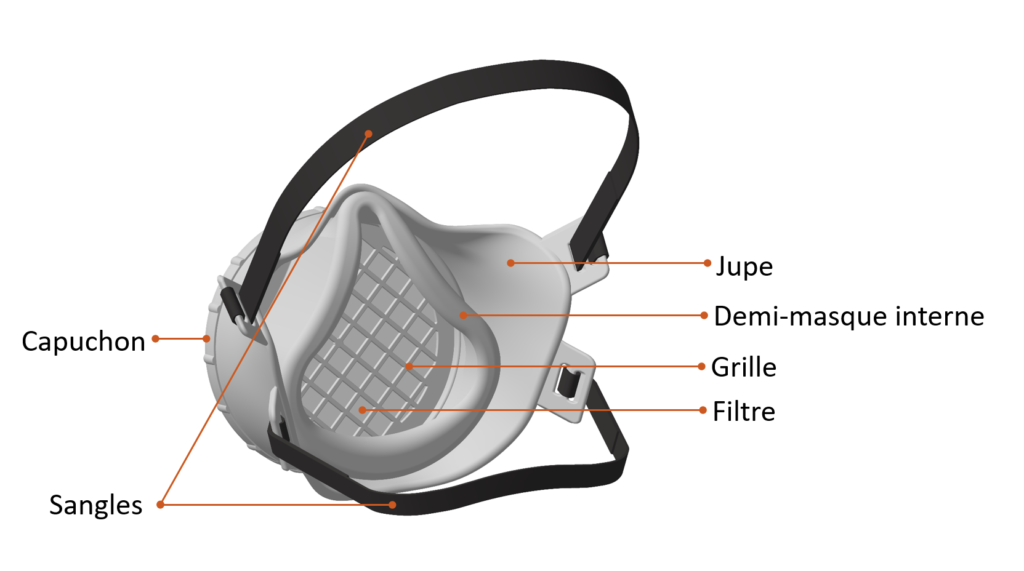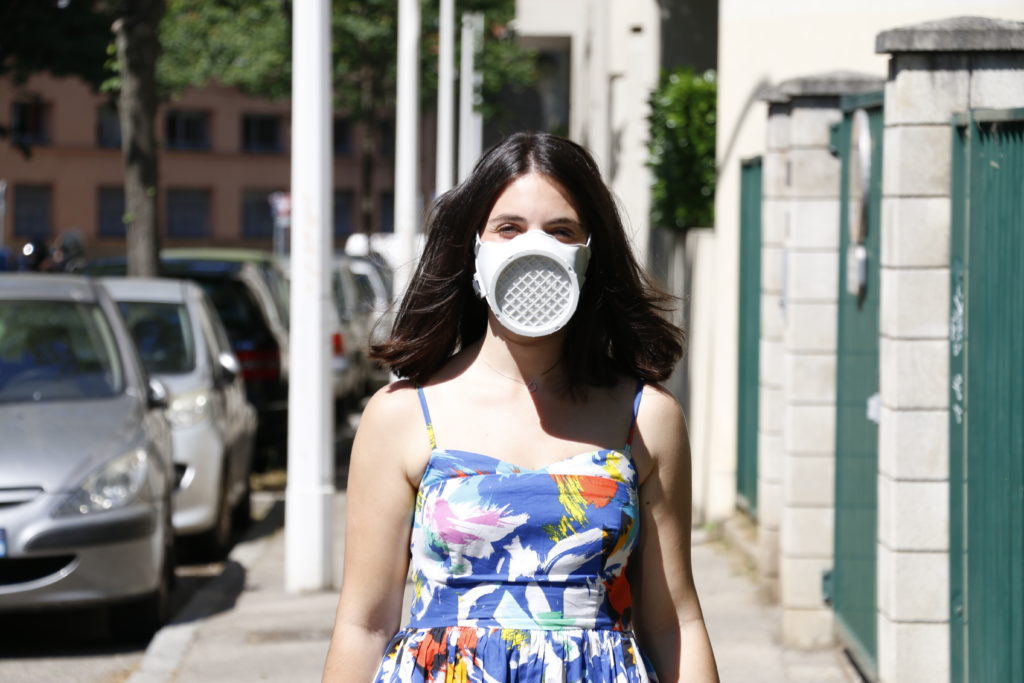What’s this all about?
We have already talked in this blog about the different masks filtering aerosols.
In this period of so-called “deconfinement”, masks are more and more in demand. It is now well understood that the wearing of masks by caregivers, professionals in contact with the public or people moving around in the street in contact with other passers-by helps to reduce contamination. Moreover, the introduction of masks for the general public standardized by AFNOR is a step in this direction.
These masks avoid projecting contaminating particles into the air and protect the wearer from contamination.
The goal of a mask is to prevent particles in the external environment from entering the respiratory tract. For this reason, its effectiveness is measured by the ratio of the amount of particles present on the outside of the mask to those that have penetrated the inside. The less the particles penetrate, the more effective the mask is.
The inward and facial leakage
How do the particles penetrate?
Particles pass through the mask in two ways: either directly through the filter without being retained, or through the interfaces at face level.
The sum of these two components is called “inward leakage”. It is therefore a function of both the filter’s capacity to retain particles and the mask’s tightness at face level (facial leakage). With the same filter, the tighter the mask is, i.e. the fewer leaks at face level, the greater the level of protection of the mask.
How do we measure facial leakage?
To measure facial leakage, the mask is fitted with a very high-filtration filter such that only a negligible amount of particles passes through it, and is then worn by a subject performing a series of standardized exercises in an enclosure into which a polydisperse NaCl aerosol centred on 0.3 µm and less than 1 µm is projected. It should be noted that this size is much smaller than that of biological aerosols generally measuring between 1 and 5 µm.
The concentration of NaCl that has penetrated into the mask is measured using a “Portacount” device, i.e. a particle counter. The device computes the ratio between the number of external particles and the number of particles that have penetrated. If, for example, 20 particles out of 100 penetrate, the ratio is 20%. This ratio is called facial leakage and corresponds to the passage of particles between the mask and the face of the wearer.
OCOV® Mask
For the OCOV® Mask, the experimentally determined ratios ranged from 46 to 53 with an average of 50, so the facial leak was 2%. This very low value can be compared with the generally higher values of other protective devices.

The various filtration devices
Surgical masks
These facial filters are responsible for filtering large particles (3 µm) from the mouth and nose to the outside environment. They must follow the EN 14683 standard which measures exclusively the filtering power of the non-woven fabric and not the leakage at the face. The reason is very simple: this filter is not at all adapted to the shape of the face, as the air passes almost freely on both sides of the filtering piece. Some authors have estimated this facial leakage rate to be close to 80%.
Respirators or filtering half masks against particles = Filtering Facepieces Particles = FFP
The EN 149+A1 standard (September 2009) defines 3 classes of disposable respiratory protection apparatus: FFP1, FFP2, FFP3. The standard takes into account filtration capacities and face leaks.
The adaptation to the face is better than in the case of the surgical filter and this is why these respiratory protection devices are designed to protect the wearer from external particles.
Inward leakage rates vary according to their classification: for FFP1 the inward leakage rate must be less than 22%, for FFP2 no more than 8% and for FFP3 no more than 2%.
Valveless half masks and FMP removable filters
They conform to the EN 1827+A1 (AFNOR) (2009) standard.
These devices consist of a skirt fitted with an FMP filter whose filtering characteristics FM P1 (80%), FM P2 (94%) and FM P3 (99.95%) are equivalent to those of the filter parts FFP1 (80%), FFP2 (94%) and FFP3 (99%). The advantage of these half masks is that they are reusable and versatile depending on the filter they are fitted with.
OCOV® Mask
It belongs to the category of FMP half masks.
We just saw that his facial leakage is extremely low.
Its filtration performance therefore depends on the filter it is fitted with.
With filters whose filtering capacities are equivalent to those of the textiles making up “masks for the general public” (AFNOR SPEC S76-001 standard, 27 April 2020) filtering more than 90% (category 1) and more than 70% (category 2), the effectiveness of the OCOV® mask will be incomparably higher than that of “masks for the general public”, whose shape is very similar to that of surgical masks. Facial leaks are not measured because they are so significant.
If the OCOV® mask is equipped with a filter whose filtration capacity is that of a surgical mask (95 and 98% filtration depending on the type), the protection it will provide will be much better than the surgical mask itself, again thanks to a very low facial leak rate.
With FM P1 filters with filtration capacities equivalent to FFP1 and FM P2 filters with filtration capacities equivalent to FFP2, the efficiency of the OCOV® mask is necessarily higher than those of the corresponding FFP masks since the adaptation to the face of OCOV® is much better than those obtained with FFP masks made up solely of a non-woven fabric used as a face piece.
Conclusion
The excellent adaptation to the face of the OCOV® half mask allows it to have an extremely low facial leak rate (2% on average).
As the protection capacities are inversely proportional to the particles that penetrate the inside of the mask without being retained at the interfaces or at the filter, OCOV® will in all cases, on an equivalent filtration scale, be more effective than the filters making up the masks currently in use (general public, surgical, FFP).
Thanks to this excellent adaptation to the face, the OCOV® mask is particularly suitable:
people who are highly exposed to liquid or solid aerosols, such as dental surgeons, nurses, personnel working in confined spaces (mines, buildings, ships, etc.), cleaning company personnel in charge of disinfection, in particular through the use of aerosol nebulisers or the use of disinfectant product jets, building and public works personnel, veterinarians, etc.
aux personnes ne pouvant respecter les mesures de distanciation (les puéricultrices en contact avec les enfants, les kinésithérapeutes…).
Bibliographie
EN 14683 (2019) : Medical face masks – Requirements and test methods
EN 1827+A1 (AFNOR) (2009). Appareils de protection respiratoire : Demi-masque sans soupape inspiratoire et avec filtre démontable, contre les gaz, contre les gaz et les particules, ou contre les particules uniquement. Exigences, essais, marquages.
EN 149+A1 ((2009) – Demi-masques filtrants contre les particules. Exigences, essais, marquages
AFNOR SPEC S76-001, 2020. Masques barrières. Guide d’exigences minimales, de méthode d’essais, de confection et d’usage.
Note d’information du 29 mars 2020, Ministère des solidarités et de la santé, Ministère de l’économie et des finances, Ministère du travail, Ministère de l’action et des comptes publics
Appareils de protection respiratoire (APR), INRS, Michèle GUIMON, 2012
Les appareils de protection respiratoire, Choix et utilisation, INRS 2019
Protection respiratoire, Réaliser des essais d’ajustement, INRS, 2016
Communication SFMC, Masques chirurgicaux et masques FFP, 2020
Atelier Geres, Risque respiratoire : les masques de protection, C. Ciotti – I. Lolom – G. Pellissier, 2018
Autor: Prof. François Renaud



